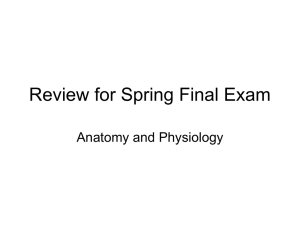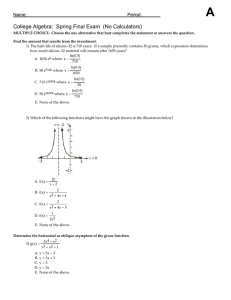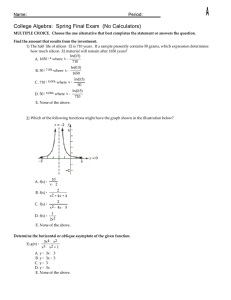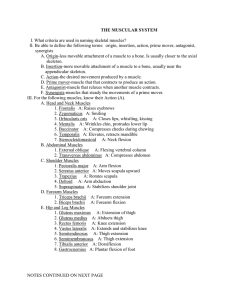NSERC PROJECT Detailed Information for Subjects Stretch Reflexes, Reaction Times, and Plasticity
advertisement
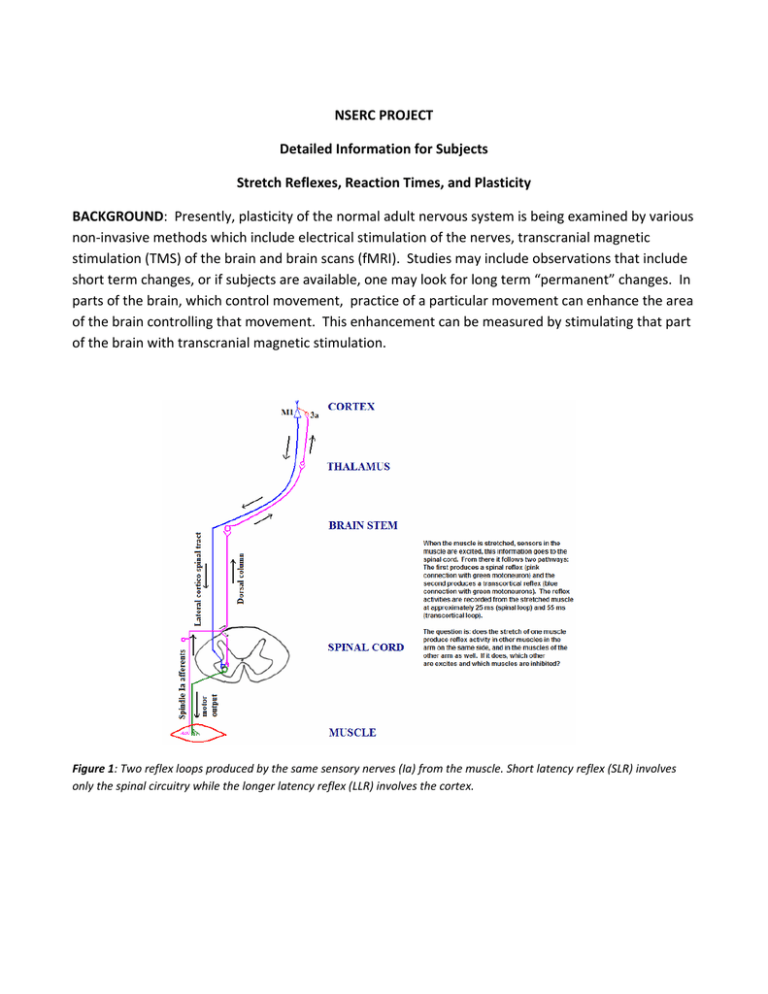
NSERC PROJECT Detailed Information for Subjects Stretch Reflexes, Reaction Times, and Plasticity BACKGROUND: Presently, plasticity of the normal adult nervous system is being examined by various non‐invasive methods which include electrical stimulation of the nerves, transcranial magnetic stimulation (TMS) of the brain and brain scans (fMRI). Studies may include observations that include short term changes, or if subjects are available, one may look for long term “permanent” changes. In parts of the brain, which control movement, practice of a particular movement can enhance the area of the brain controlling that movement. This enhancement can be measured by stimulating that part of the brain with transcranial magnetic stimulation. Figure 1: Two reflex loops produced by the same sensory nerves (Ia) from the muscle. Short latency reflex (SLR) involves only the spinal circuitry while the longer latency reflex (LLR) involves the cortex. Figure 2: Left: A set up to stretch either wrist flexor or extensor muscles shown only for the right forearm. Right: Seating of the subject for these experiments. Muscles of the right forearm will be stretched; the subject will react to the stretch with both hands. Figure 3: This figure shows the location of forearm muscles for recording surface EMG from wrist flexor and extensor muscles of the right side. S-EMG will also be recorded from biceps and triceps brachii muscles of the right upper arm (not shown). Surface EMG will also be recorded from wrist flexors and extensors of the left forearm (two pairs of electrodes). METHODS: Skin overlying the muscles of interest will be cleaned with alcohol. If the arm is hairy, it will be shaved with a new disposable razor. The subject will sit in a comfortable chair with the each forearm resting on a horizontal platform (shown in figure 3). The right arm will be prepared for stretch of either wrist flexor or extensor muscles with a torque pulse, whereas the left arm will not be perturbed by any external torque or force. Surface EMG activity will be recorded from wrist flexors, wrist extensors, biceps brachii (BiBr) and triceps brachii (TriBr). We may put an electrode on one of the hand muscles (first dorsal interosseous) as well. Surface EMG will also be recorded from main flexors and extensors in the left arm. Upon perturbation, the subject will react with both hands to the stretch applied to the right wrist in two ways – (i) as fast as possible, or (ii) not react at all. At this time it is understood that this stretch will produce a short latency reflex (SLR), a long latency reflex (LLR) and voluntary activity in the stretched muscles of the right side. Conversely we expect to witness only the voluntary activity on the un‐stretched left side. We also expect the amplitude of sEMG response to be dependent on prior instruction, with the amplitude of LLR being small when not reacting, and large when instructed to react quickly. The characteristics of the SLR and LLR of the EMG will be recorded from a number of muscles on both sides, and the reaction times will be analyzed. From these data additional information to be obtained is: (1) The main characteristics of SLR, LLR and i.e. latency, amplitude modulation of LLR, reaction times on both sides and variability in proprioceptive RTs. [Proprioceptive means originating from the muscle receptors. A lot of RT work has been done for visual and auditory stimuli] (2) Distribution of SLR, LLR in muscles other than the one stretched will be measured on both sides and compared among various age groups. (3) Improvement of gain modulation of LLR among younger and older groups at the beginning and at the end of the experiment (an estimate of central plasticity in the two age groups). (4) If there is a tremor peak in older adults compared to younger ones in their background EMG. Is there a difference in the frequency of tremor between the younger and the older group? (5) Reaction time varies from trial to trial. Is the standard deviation between young and old different? Is there a decrease in variability with practice? These questions will be addressed to investigate plasticity in the two age groups. PROCEDURE FOR DATA COLLECTION The subject comes to the laboratory and is briefed on what they will do. They are told that they can stop their participation in these experiments any time without feeling bad. If, for some reason the subject feels that they do not want to participate at all, it is absolutely alright with us. The comfort of our subject, both physical and mental, is absolutely important to us for ethical reasons and to obtain good data. If they decide, they want to go ahead, they will sign the Consent Form. In most cases, the forearms will be shaved with new disposable razors, skin will be cleaned with alcohol. Five pairs of electrodes will be secured on the skin overlying various muscles of interest of the right arm. Two pairs of electrodes will be placed on the left forearm. The subject will then sit in a comfortable chair as shown in Figure 3. They can ask for a more comfortable cushion and a backrest if need be. At this stage, the subject will again be explained what they need to do when the motor moves their hand and a few practice runs will be given. If the subject is ready to go ahead, proper data collection will start. Please note that if you do want to participate but cannot sit through the whole procedure, only half of Protocol we can test only the flexors or only the extensors. EQUIPMENT for DATA COLLECTION and STORAGE OF DATA The electrodes wires from the subject are connected to amplifiers, from which the data are sent to the computer. You will see a lot of screens, those are just for the experimenters to check correct recording of the data coming in. All equipment in our laboratory is approved by Canadian Safety Association (CSA) or equivalent approved agencies. While the subject is performing the experiments, data are collected on our computers. It is analysed later for information we need to extract. The data are stored and kept on our computers for at least two years after the work is published. The notes about the data are kept in our lab books without the name of the subject—the lab book has only the code assigned to the subject. These lab books are destroyed by shredding the sheets—again 2 years after publication. COFIDENTIALITY Instead of the subject’s name, data will be recorded with a code assigned to each subject. Only the principal investigator will know the correspondence between each code and the subject. These data are not discussed with anyone except with the research assistant/graduate student in the lab. You will all probably meet him. He knows about the ethics of confidentiality involving human experiments. RECRUITMENT OF SUBJECTS Subjects will definitely not be recruited by posters or mass emails to classes. (i) If we know the subjects personally, we will ask then face‐to‐face, by phone or by email. All our younger group of subjects fall in this category, and many of the older subjects also belong to this category. We will ask the potential subject if they can get involved with experiments, explain main details of the first experiment. If they agree, we will send them the Consent Form and the Information for Subjects document. Various members of SFU Retirees Association, of which I am a member now, will be approached by personally.
